Sociology Evaluation and Policy Process: Their Futures Matter Program
VerifiedAdded on 2023/03/30
|10
|2060
|247
Report
AI Summary
This report presents a sociology evaluation proposal for the 'Their Futures Matter' program in New South Wales, Australia. The evaluation aims to build a strong evidence base to inform decisions on improving outcomes for vulnerable children and families. The proposal outlines the aims, objectives, research questions, and the chosen approach and methods, including program logic and a combination of experimental and quasi-experimental design. The report also addresses ethical considerations, such as confidentiality and respect for families, as well as political issues related to data collection and privacy. The proposal compares the selected evaluation approach with the formative evaluation approach, highlighting the strengths and weaknesses of each. The ultimate goal is to provide recommendations for the NSW government to enhance the program's effectiveness and ensure better outcomes for the target population. The report also includes a detailed reference list of sources consulted.
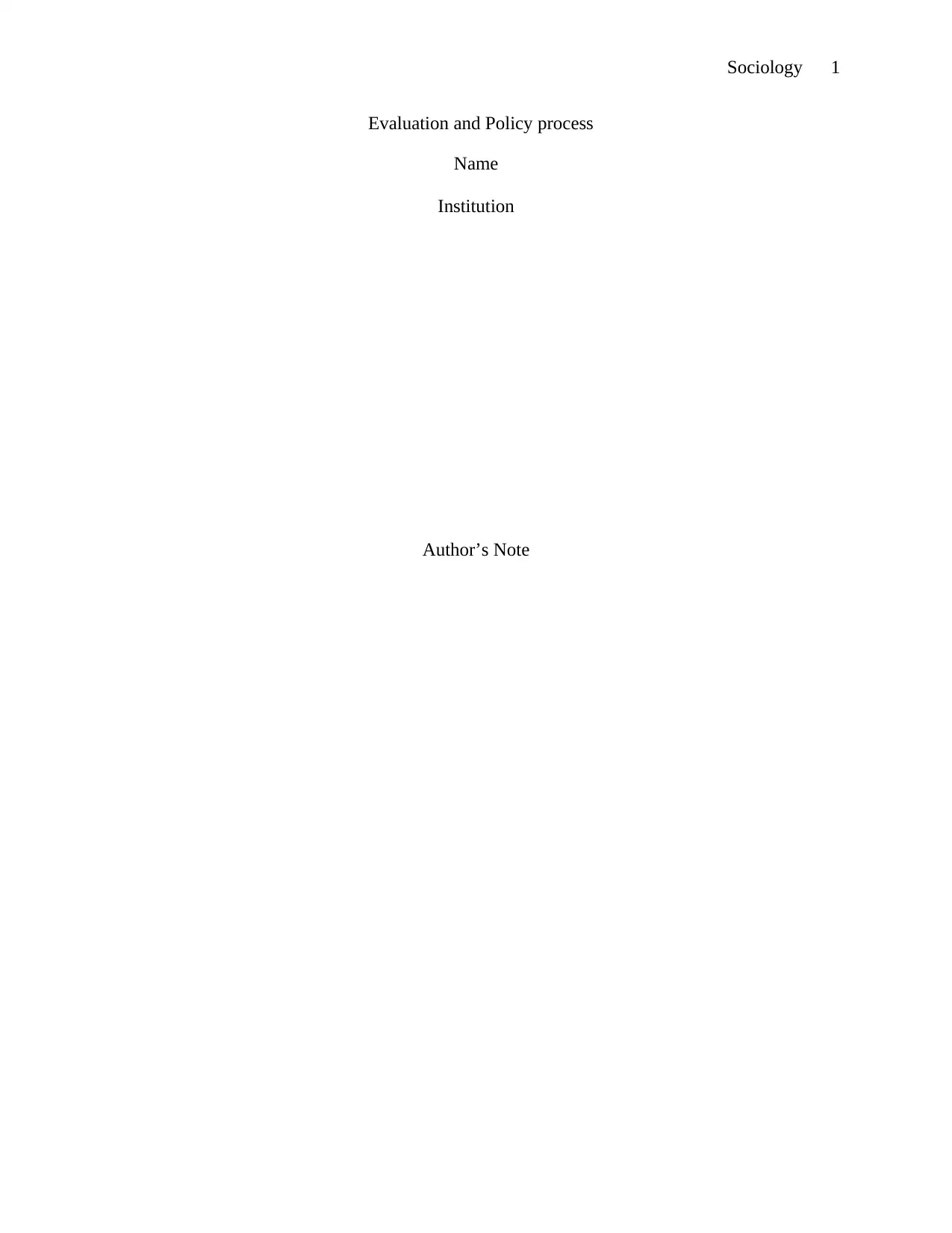
Sociology 1
Evaluation and Policy process
Name
Institution
Author’s Note
Evaluation and Policy process
Name
Institution
Author’s Note
Paraphrase This Document
Need a fresh take? Get an instant paraphrase of this document with our AI Paraphraser
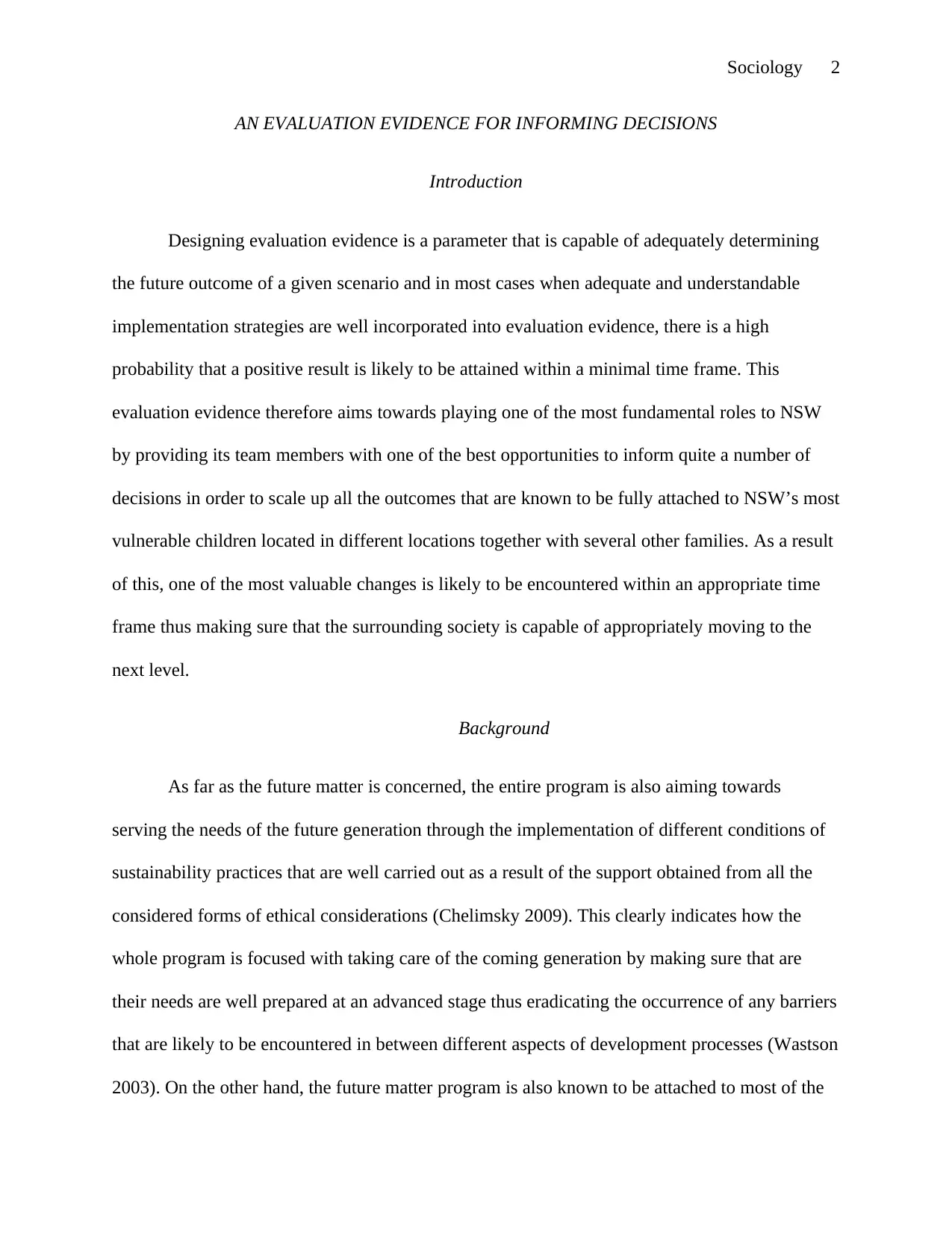
Sociology 2
AN EVALUATION EVIDENCE FOR INFORMING DECISIONS
Introduction
Designing evaluation evidence is a parameter that is capable of adequately determining
the future outcome of a given scenario and in most cases when adequate and understandable
implementation strategies are well incorporated into evaluation evidence, there is a high
probability that a positive result is likely to be attained within a minimal time frame. This
evaluation evidence therefore aims towards playing one of the most fundamental roles to NSW
by providing its team members with one of the best opportunities to inform quite a number of
decisions in order to scale up all the outcomes that are known to be fully attached to NSW’s most
vulnerable children located in different locations together with several other families. As a result
of this, one of the most valuable changes is likely to be encountered within an appropriate time
frame thus making sure that the surrounding society is capable of appropriately moving to the
next level.
Background
As far as the future matter is concerned, the entire program is also aiming towards
serving the needs of the future generation through the implementation of different conditions of
sustainability practices that are well carried out as a result of the support obtained from all the
considered forms of ethical considerations (Chelimsky 2009). This clearly indicates how the
whole program is focused with taking care of the coming generation by making sure that are
their needs are well prepared at an advanced stage thus eradicating the occurrence of any barriers
that are likely to be encountered in between different aspects of development processes (Wastson
2003). On the other hand, the future matter program is also known to be attached to most of the
AN EVALUATION EVIDENCE FOR INFORMING DECISIONS
Introduction
Designing evaluation evidence is a parameter that is capable of adequately determining
the future outcome of a given scenario and in most cases when adequate and understandable
implementation strategies are well incorporated into evaluation evidence, there is a high
probability that a positive result is likely to be attained within a minimal time frame. This
evaluation evidence therefore aims towards playing one of the most fundamental roles to NSW
by providing its team members with one of the best opportunities to inform quite a number of
decisions in order to scale up all the outcomes that are known to be fully attached to NSW’s most
vulnerable children located in different locations together with several other families. As a result
of this, one of the most valuable changes is likely to be encountered within an appropriate time
frame thus making sure that the surrounding society is capable of appropriately moving to the
next level.
Background
As far as the future matter is concerned, the entire program is also aiming towards
serving the needs of the future generation through the implementation of different conditions of
sustainability practices that are well carried out as a result of the support obtained from all the
considered forms of ethical considerations (Chelimsky 2009). This clearly indicates how the
whole program is focused with taking care of the coming generation by making sure that are
their needs are well prepared at an advanced stage thus eradicating the occurrence of any barriers
that are likely to be encountered in between different aspects of development processes (Wastson
2003). On the other hand, the future matter program is also known to be attached to most of the
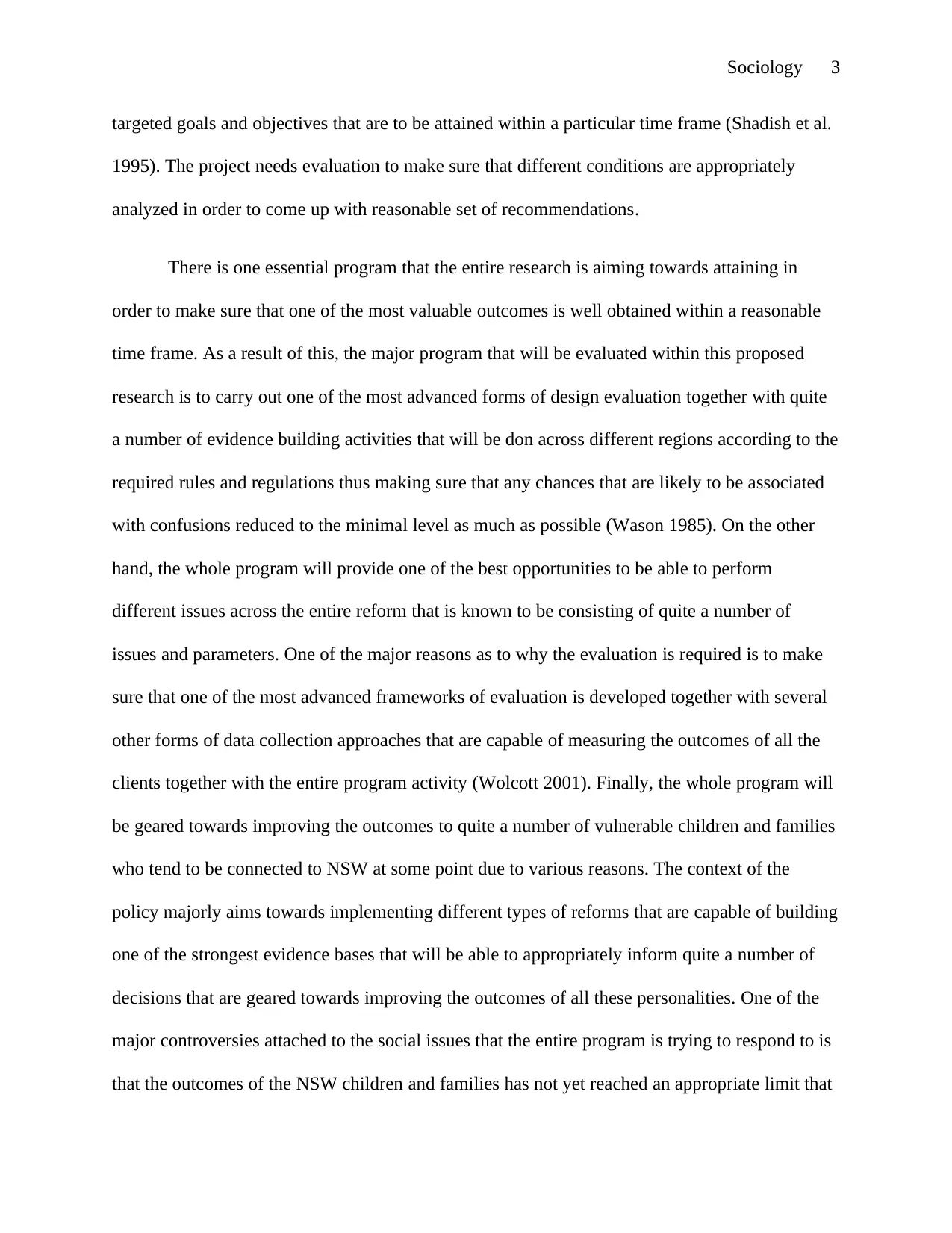
Sociology 3
targeted goals and objectives that are to be attained within a particular time frame (Shadish et al.
1995). The project needs evaluation to make sure that different conditions are appropriately
analyzed in order to come up with reasonable set of recommendations.
There is one essential program that the entire research is aiming towards attaining in
order to make sure that one of the most valuable outcomes is well obtained within a reasonable
time frame. As a result of this, the major program that will be evaluated within this proposed
research is to carry out one of the most advanced forms of design evaluation together with quite
a number of evidence building activities that will be don across different regions according to the
required rules and regulations thus making sure that any chances that are likely to be associated
with confusions reduced to the minimal level as much as possible (Wason 1985). On the other
hand, the whole program will provide one of the best opportunities to be able to perform
different issues across the entire reform that is known to be consisting of quite a number of
issues and parameters. One of the major reasons as to why the evaluation is required is to make
sure that one of the most advanced frameworks of evaluation is developed together with several
other forms of data collection approaches that are capable of measuring the outcomes of all the
clients together with the entire program activity (Wolcott 2001). Finally, the whole program will
be geared towards improving the outcomes to quite a number of vulnerable children and families
who tend to be connected to NSW at some point due to various reasons. The context of the
policy majorly aims towards implementing different types of reforms that are capable of building
one of the strongest evidence bases that will be able to appropriately inform quite a number of
decisions that are geared towards improving the outcomes of all these personalities. One of the
major controversies attached to the social issues that the entire program is trying to respond to is
that the outcomes of the NSW children and families has not yet reached an appropriate limit that
targeted goals and objectives that are to be attained within a particular time frame (Shadish et al.
1995). The project needs evaluation to make sure that different conditions are appropriately
analyzed in order to come up with reasonable set of recommendations.
There is one essential program that the entire research is aiming towards attaining in
order to make sure that one of the most valuable outcomes is well obtained within a reasonable
time frame. As a result of this, the major program that will be evaluated within this proposed
research is to carry out one of the most advanced forms of design evaluation together with quite
a number of evidence building activities that will be don across different regions according to the
required rules and regulations thus making sure that any chances that are likely to be associated
with confusions reduced to the minimal level as much as possible (Wason 1985). On the other
hand, the whole program will provide one of the best opportunities to be able to perform
different issues across the entire reform that is known to be consisting of quite a number of
issues and parameters. One of the major reasons as to why the evaluation is required is to make
sure that one of the most advanced frameworks of evaluation is developed together with several
other forms of data collection approaches that are capable of measuring the outcomes of all the
clients together with the entire program activity (Wolcott 2001). Finally, the whole program will
be geared towards improving the outcomes to quite a number of vulnerable children and families
who tend to be connected to NSW at some point due to various reasons. The context of the
policy majorly aims towards implementing different types of reforms that are capable of building
one of the strongest evidence bases that will be able to appropriately inform quite a number of
decisions that are geared towards improving the outcomes of all these personalities. One of the
major controversies attached to the social issues that the entire program is trying to respond to is
that the outcomes of the NSW children and families has not yet reached an appropriate limit that
⊘ This is a preview!⊘
Do you want full access?
Subscribe today to unlock all pages.

Trusted by 1+ million students worldwide
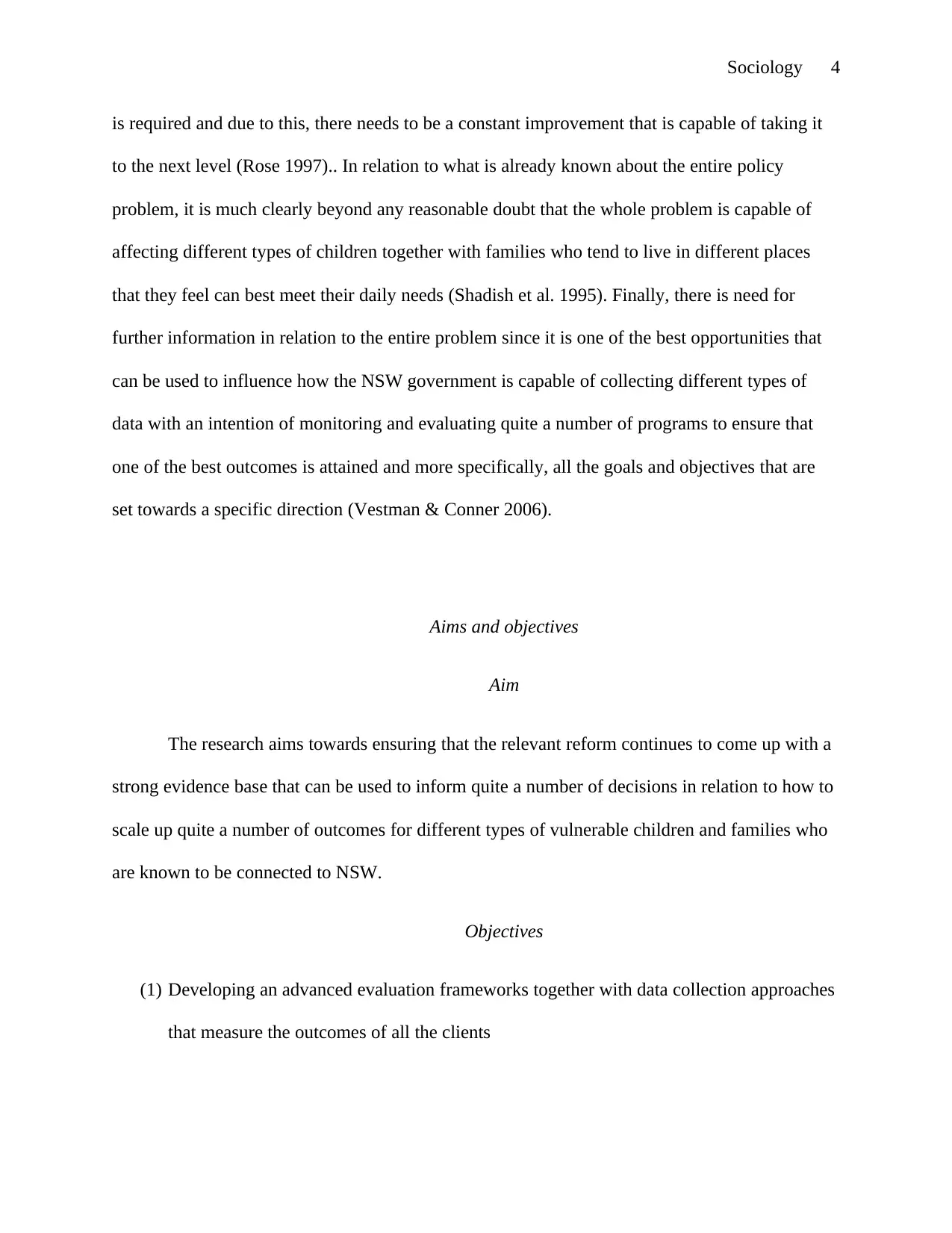
Sociology 4
is required and due to this, there needs to be a constant improvement that is capable of taking it
to the next level (Rose 1997).. In relation to what is already known about the entire policy
problem, it is much clearly beyond any reasonable doubt that the whole problem is capable of
affecting different types of children together with families who tend to live in different places
that they feel can best meet their daily needs (Shadish et al. 1995). Finally, there is need for
further information in relation to the entire problem since it is one of the best opportunities that
can be used to influence how the NSW government is capable of collecting different types of
data with an intention of monitoring and evaluating quite a number of programs to ensure that
one of the best outcomes is attained and more specifically, all the goals and objectives that are
set towards a specific direction (Vestman & Conner 2006).
Aims and objectives
Aim
The research aims towards ensuring that the relevant reform continues to come up with a
strong evidence base that can be used to inform quite a number of decisions in relation to how to
scale up quite a number of outcomes for different types of vulnerable children and families who
are known to be connected to NSW.
Objectives
(1) Developing an advanced evaluation frameworks together with data collection approaches
that measure the outcomes of all the clients
is required and due to this, there needs to be a constant improvement that is capable of taking it
to the next level (Rose 1997).. In relation to what is already known about the entire policy
problem, it is much clearly beyond any reasonable doubt that the whole problem is capable of
affecting different types of children together with families who tend to live in different places
that they feel can best meet their daily needs (Shadish et al. 1995). Finally, there is need for
further information in relation to the entire problem since it is one of the best opportunities that
can be used to influence how the NSW government is capable of collecting different types of
data with an intention of monitoring and evaluating quite a number of programs to ensure that
one of the best outcomes is attained and more specifically, all the goals and objectives that are
set towards a specific direction (Vestman & Conner 2006).
Aims and objectives
Aim
The research aims towards ensuring that the relevant reform continues to come up with a
strong evidence base that can be used to inform quite a number of decisions in relation to how to
scale up quite a number of outcomes for different types of vulnerable children and families who
are known to be connected to NSW.
Objectives
(1) Developing an advanced evaluation frameworks together with data collection approaches
that measure the outcomes of all the clients
Paraphrase This Document
Need a fresh take? Get an instant paraphrase of this document with our AI Paraphraser
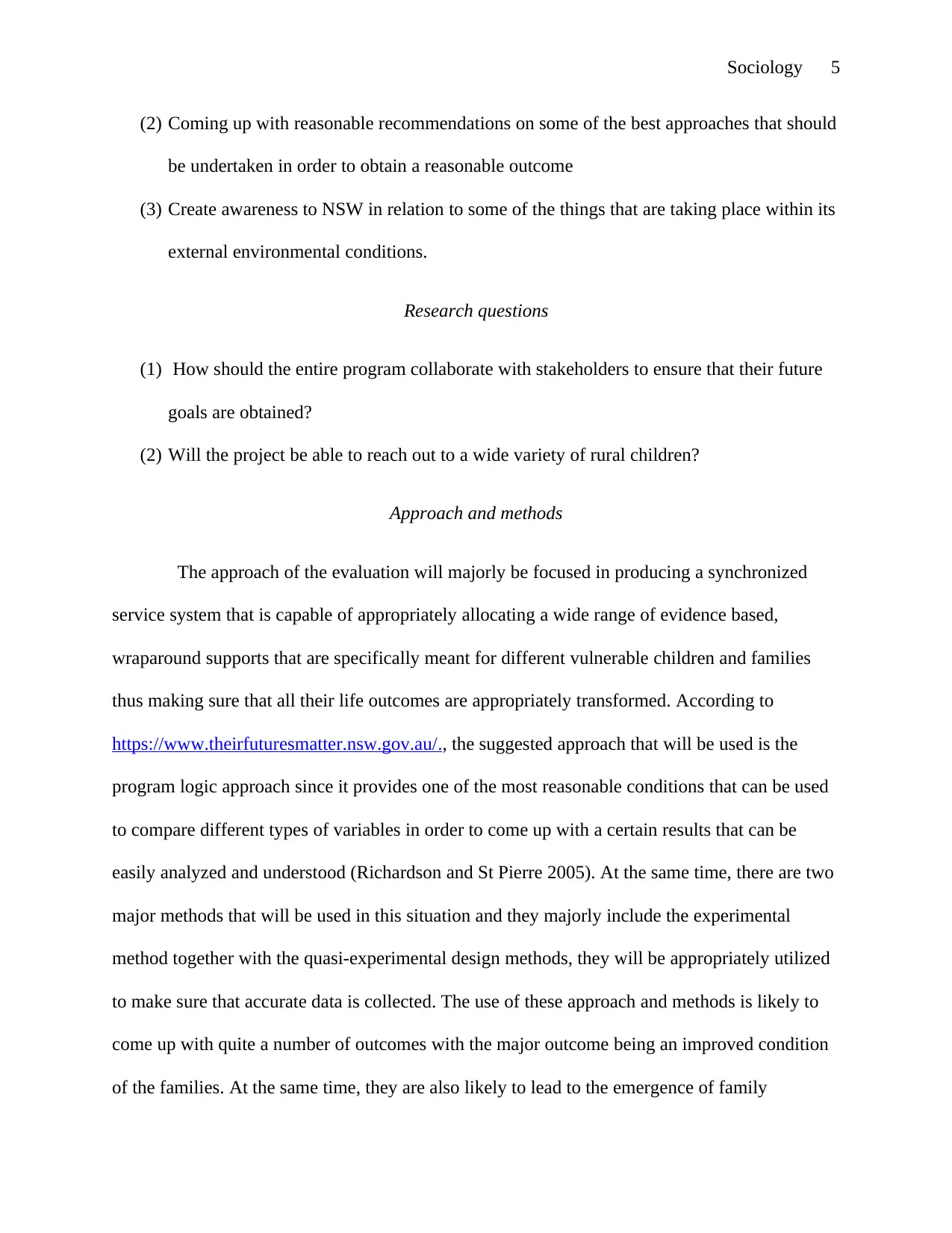
Sociology 5
(2) Coming up with reasonable recommendations on some of the best approaches that should
be undertaken in order to obtain a reasonable outcome
(3) Create awareness to NSW in relation to some of the things that are taking place within its
external environmental conditions.
Research questions
(1) How should the entire program collaborate with stakeholders to ensure that their future
goals are obtained?
(2) Will the project be able to reach out to a wide variety of rural children?
Approach and methods
The approach of the evaluation will majorly be focused in producing a synchronized
service system that is capable of appropriately allocating a wide range of evidence based,
wraparound supports that are specifically meant for different vulnerable children and families
thus making sure that all their life outcomes are appropriately transformed. According to
https://www.theirfuturesmatter.nsw.gov.au/., the suggested approach that will be used is the
program logic approach since it provides one of the most reasonable conditions that can be used
to compare different types of variables in order to come up with a certain results that can be
easily analyzed and understood (Richardson and St Pierre 2005). At the same time, there are two
major methods that will be used in this situation and they majorly include the experimental
method together with the quasi-experimental design methods, they will be appropriately utilized
to make sure that accurate data is collected. The use of these approach and methods is likely to
come up with quite a number of outcomes with the major outcome being an improved condition
of the families. At the same time, they are also likely to lead to the emergence of family
(2) Coming up with reasonable recommendations on some of the best approaches that should
be undertaken in order to obtain a reasonable outcome
(3) Create awareness to NSW in relation to some of the things that are taking place within its
external environmental conditions.
Research questions
(1) How should the entire program collaborate with stakeholders to ensure that their future
goals are obtained?
(2) Will the project be able to reach out to a wide variety of rural children?
Approach and methods
The approach of the evaluation will majorly be focused in producing a synchronized
service system that is capable of appropriately allocating a wide range of evidence based,
wraparound supports that are specifically meant for different vulnerable children and families
thus making sure that all their life outcomes are appropriately transformed. According to
https://www.theirfuturesmatter.nsw.gov.au/., the suggested approach that will be used is the
program logic approach since it provides one of the most reasonable conditions that can be used
to compare different types of variables in order to come up with a certain results that can be
easily analyzed and understood (Richardson and St Pierre 2005). At the same time, there are two
major methods that will be used in this situation and they majorly include the experimental
method together with the quasi-experimental design methods, they will be appropriately utilized
to make sure that accurate data is collected. The use of these approach and methods is likely to
come up with quite a number of outcomes with the major outcome being an improved condition
of the families. At the same time, they are also likely to lead to the emergence of family
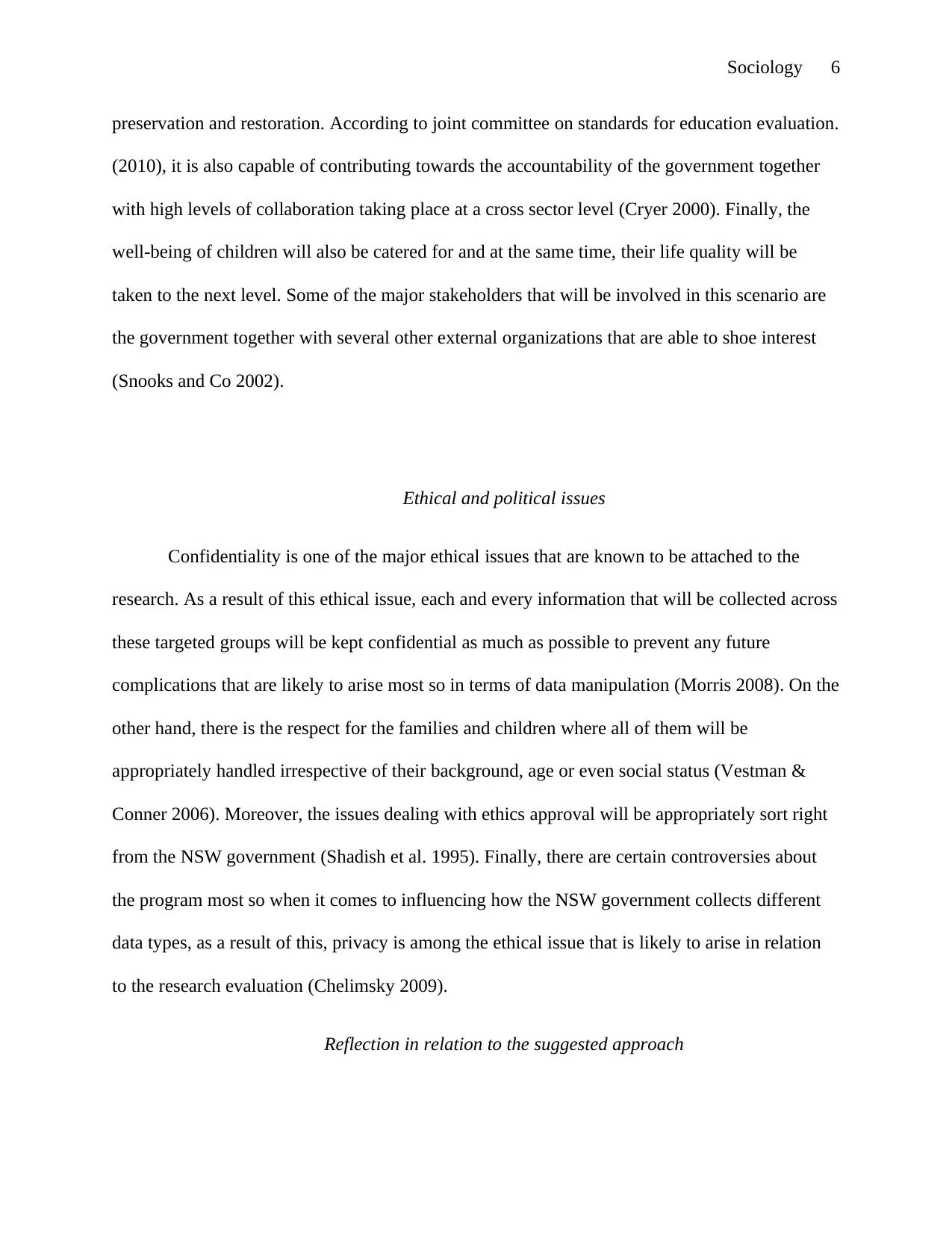
Sociology 6
preservation and restoration. According to joint committee on standards for education evaluation.
(2010), it is also capable of contributing towards the accountability of the government together
with high levels of collaboration taking place at a cross sector level (Cryer 2000). Finally, the
well-being of children will also be catered for and at the same time, their life quality will be
taken to the next level. Some of the major stakeholders that will be involved in this scenario are
the government together with several other external organizations that are able to shoe interest
(Snooks and Co 2002).
Ethical and political issues
Confidentiality is one of the major ethical issues that are known to be attached to the
research. As a result of this ethical issue, each and every information that will be collected across
these targeted groups will be kept confidential as much as possible to prevent any future
complications that are likely to arise most so in terms of data manipulation (Morris 2008). On the
other hand, there is the respect for the families and children where all of them will be
appropriately handled irrespective of their background, age or even social status (Vestman &
Conner 2006). Moreover, the issues dealing with ethics approval will be appropriately sort right
from the NSW government (Shadish et al. 1995). Finally, there are certain controversies about
the program most so when it comes to influencing how the NSW government collects different
data types, as a result of this, privacy is among the ethical issue that is likely to arise in relation
to the research evaluation (Chelimsky 2009).
Reflection in relation to the suggested approach
preservation and restoration. According to joint committee on standards for education evaluation.
(2010), it is also capable of contributing towards the accountability of the government together
with high levels of collaboration taking place at a cross sector level (Cryer 2000). Finally, the
well-being of children will also be catered for and at the same time, their life quality will be
taken to the next level. Some of the major stakeholders that will be involved in this scenario are
the government together with several other external organizations that are able to shoe interest
(Snooks and Co 2002).
Ethical and political issues
Confidentiality is one of the major ethical issues that are known to be attached to the
research. As a result of this ethical issue, each and every information that will be collected across
these targeted groups will be kept confidential as much as possible to prevent any future
complications that are likely to arise most so in terms of data manipulation (Morris 2008). On the
other hand, there is the respect for the families and children where all of them will be
appropriately handled irrespective of their background, age or even social status (Vestman &
Conner 2006). Moreover, the issues dealing with ethics approval will be appropriately sort right
from the NSW government (Shadish et al. 1995). Finally, there are certain controversies about
the program most so when it comes to influencing how the NSW government collects different
data types, as a result of this, privacy is among the ethical issue that is likely to arise in relation
to the research evaluation (Chelimsky 2009).
Reflection in relation to the suggested approach
⊘ This is a preview!⊘
Do you want full access?
Subscribe today to unlock all pages.

Trusted by 1+ million students worldwide
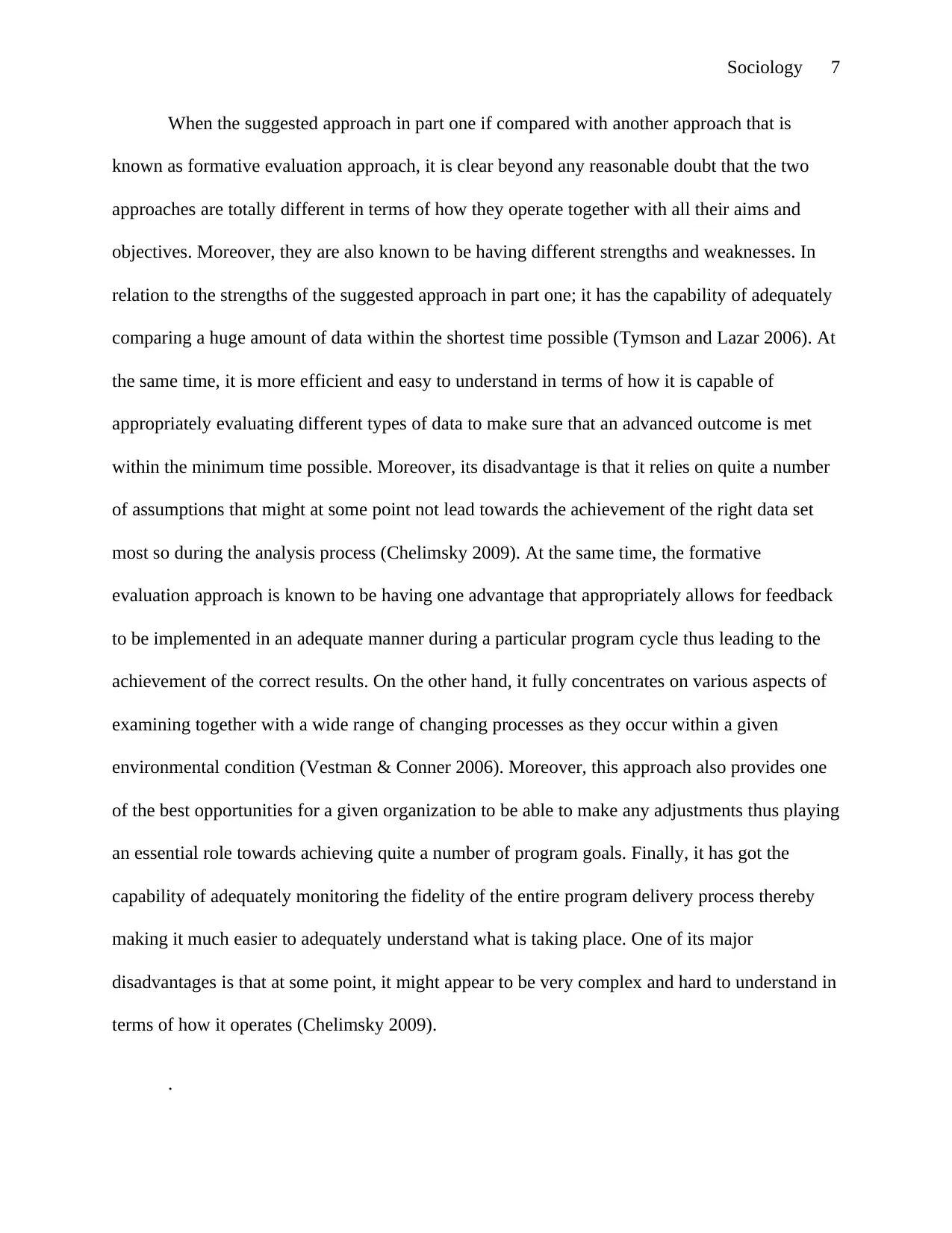
Sociology 7
When the suggested approach in part one if compared with another approach that is
known as formative evaluation approach, it is clear beyond any reasonable doubt that the two
approaches are totally different in terms of how they operate together with all their aims and
objectives. Moreover, they are also known to be having different strengths and weaknesses. In
relation to the strengths of the suggested approach in part one; it has the capability of adequately
comparing a huge amount of data within the shortest time possible (Tymson and Lazar 2006). At
the same time, it is more efficient and easy to understand in terms of how it is capable of
appropriately evaluating different types of data to make sure that an advanced outcome is met
within the minimum time possible. Moreover, its disadvantage is that it relies on quite a number
of assumptions that might at some point not lead towards the achievement of the right data set
most so during the analysis process (Chelimsky 2009). At the same time, the formative
evaluation approach is known to be having one advantage that appropriately allows for feedback
to be implemented in an adequate manner during a particular program cycle thus leading to the
achievement of the correct results. On the other hand, it fully concentrates on various aspects of
examining together with a wide range of changing processes as they occur within a given
environmental condition (Vestman & Conner 2006). Moreover, this approach also provides one
of the best opportunities for a given organization to be able to make any adjustments thus playing
an essential role towards achieving quite a number of program goals. Finally, it has got the
capability of adequately monitoring the fidelity of the entire program delivery process thereby
making it much easier to adequately understand what is taking place. One of its major
disadvantages is that at some point, it might appear to be very complex and hard to understand in
terms of how it operates (Chelimsky 2009).
.
When the suggested approach in part one if compared with another approach that is
known as formative evaluation approach, it is clear beyond any reasonable doubt that the two
approaches are totally different in terms of how they operate together with all their aims and
objectives. Moreover, they are also known to be having different strengths and weaknesses. In
relation to the strengths of the suggested approach in part one; it has the capability of adequately
comparing a huge amount of data within the shortest time possible (Tymson and Lazar 2006). At
the same time, it is more efficient and easy to understand in terms of how it is capable of
appropriately evaluating different types of data to make sure that an advanced outcome is met
within the minimum time possible. Moreover, its disadvantage is that it relies on quite a number
of assumptions that might at some point not lead towards the achievement of the right data set
most so during the analysis process (Chelimsky 2009). At the same time, the formative
evaluation approach is known to be having one advantage that appropriately allows for feedback
to be implemented in an adequate manner during a particular program cycle thus leading to the
achievement of the correct results. On the other hand, it fully concentrates on various aspects of
examining together with a wide range of changing processes as they occur within a given
environmental condition (Vestman & Conner 2006). Moreover, this approach also provides one
of the best opportunities for a given organization to be able to make any adjustments thus playing
an essential role towards achieving quite a number of program goals. Finally, it has got the
capability of adequately monitoring the fidelity of the entire program delivery process thereby
making it much easier to adequately understand what is taking place. One of its major
disadvantages is that at some point, it might appear to be very complex and hard to understand in
terms of how it operates (Chelimsky 2009).
.
Paraphrase This Document
Need a fresh take? Get an instant paraphrase of this document with our AI Paraphraser

Sociology 8
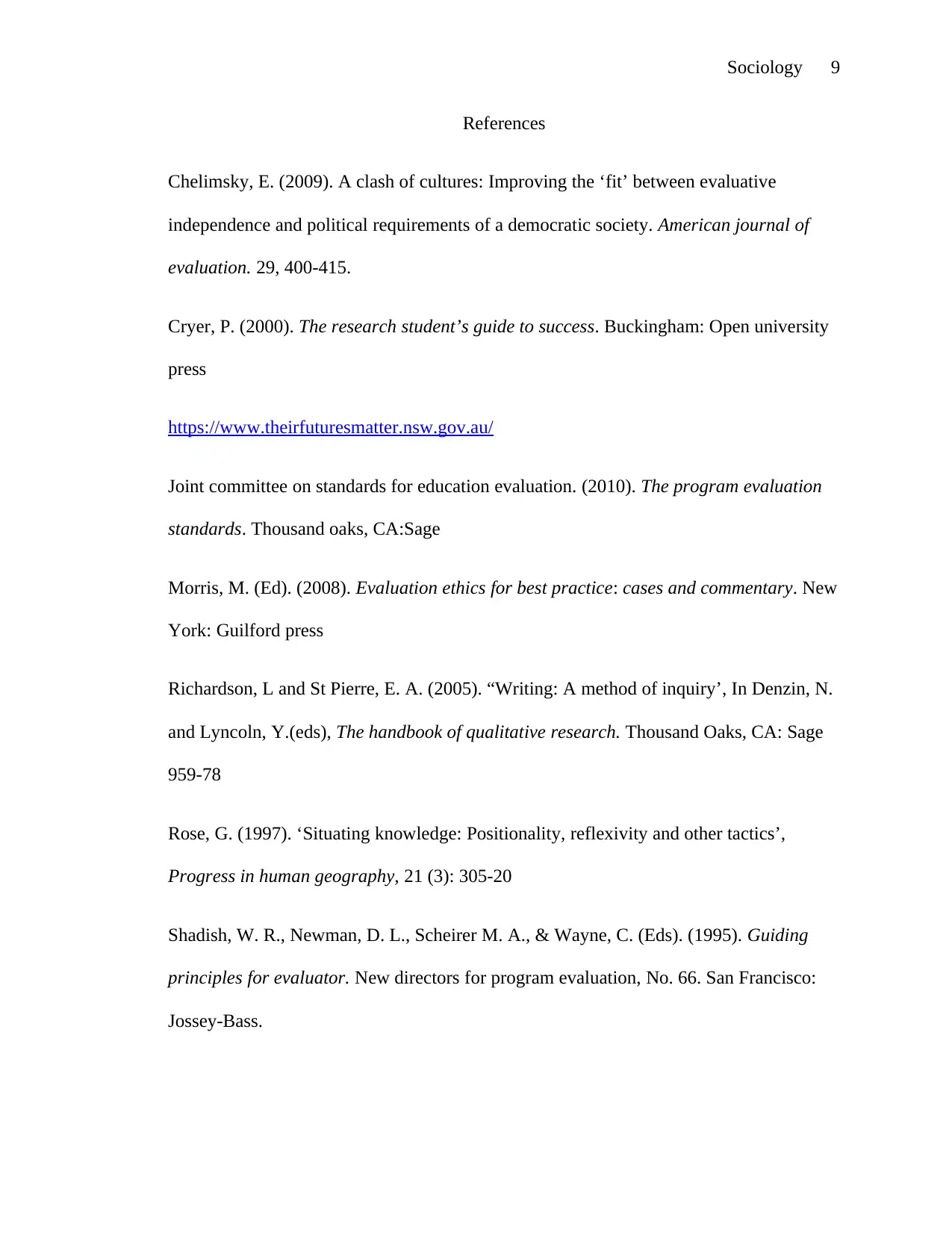
Sociology 9
References
Chelimsky, E. (2009). A clash of cultures: Improving the ‘fit’ between evaluative
independence and political requirements of a democratic society. American journal of
evaluation. 29, 400-415.
Cryer, P. (2000). The research student’s guide to success. Buckingham: Open university
press
https://www.theirfuturesmatter.nsw.gov.au/
Joint committee on standards for education evaluation. (2010). The program evaluation
standards. Thousand oaks, CA:Sage
Morris, M. (Ed). (2008). Evaluation ethics for best practice: cases and commentary. New
York: Guilford press
Richardson, L and St Pierre, E. A. (2005). “Writing: A method of inquiry’, In Denzin, N.
and Lyncoln, Y.(eds), The handbook of qualitative research. Thousand Oaks, CA: Sage
959-78
Rose, G. (1997). ‘Situating knowledge: Positionality, reflexivity and other tactics’,
Progress in human geography, 21 (3): 305-20
Shadish, W. R., Newman, D. L., Scheirer M. A., & Wayne, C. (Eds). (1995). Guiding
principles for evaluator. New directors for program evaluation, No. 66. San Francisco:
Jossey-Bass.
References
Chelimsky, E. (2009). A clash of cultures: Improving the ‘fit’ between evaluative
independence and political requirements of a democratic society. American journal of
evaluation. 29, 400-415.
Cryer, P. (2000). The research student’s guide to success. Buckingham: Open university
press
https://www.theirfuturesmatter.nsw.gov.au/
Joint committee on standards for education evaluation. (2010). The program evaluation
standards. Thousand oaks, CA:Sage
Morris, M. (Ed). (2008). Evaluation ethics for best practice: cases and commentary. New
York: Guilford press
Richardson, L and St Pierre, E. A. (2005). “Writing: A method of inquiry’, In Denzin, N.
and Lyncoln, Y.(eds), The handbook of qualitative research. Thousand Oaks, CA: Sage
959-78
Rose, G. (1997). ‘Situating knowledge: Positionality, reflexivity and other tactics’,
Progress in human geography, 21 (3): 305-20
Shadish, W. R., Newman, D. L., Scheirer M. A., & Wayne, C. (Eds). (1995). Guiding
principles for evaluator. New directors for program evaluation, No. 66. San Francisco:
Jossey-Bass.
⊘ This is a preview!⊘
Do you want full access?
Subscribe today to unlock all pages.

Trusted by 1+ million students worldwide
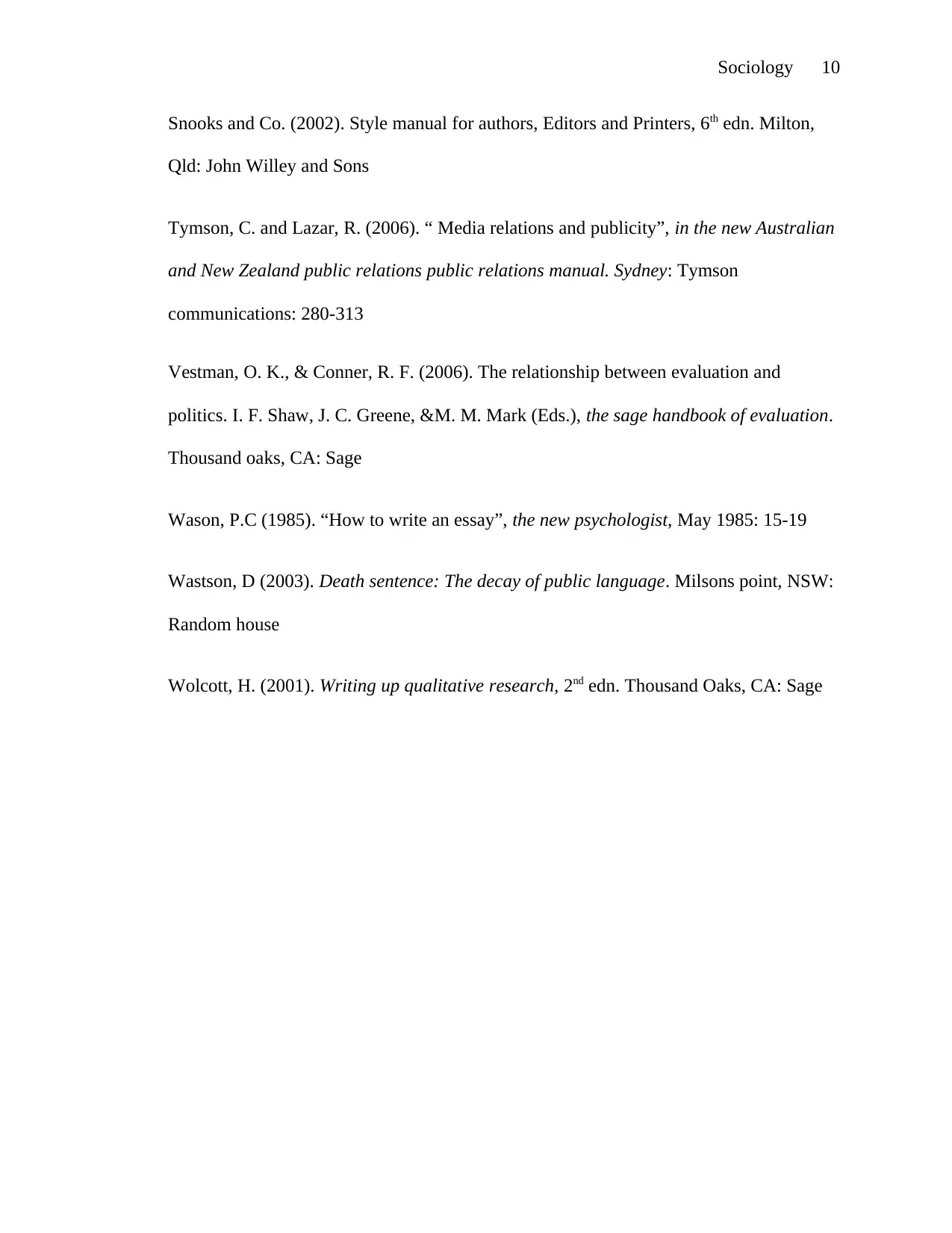
Sociology 10
Snooks and Co. (2002). Style manual for authors, Editors and Printers, 6th edn. Milton,
Qld: John Willey and Sons
Tymson, C. and Lazar, R. (2006). “ Media relations and publicity”, in the new Australian
and New Zealand public relations public relations manual. Sydney: Tymson
communications: 280-313
Vestman, O. K., & Conner, R. F. (2006). The relationship between evaluation and
politics. I. F. Shaw, J. C. Greene, &M. M. Mark (Eds.), the sage handbook of evaluation.
Thousand oaks, CA: Sage
Wason, P.C (1985). “How to write an essay”, the new psychologist, May 1985: 15-19
Wastson, D (2003). Death sentence: The decay of public language. Milsons point, NSW:
Random house
Wolcott, H. (2001). Writing up qualitative research, 2nd edn. Thousand Oaks, CA: Sage
Snooks and Co. (2002). Style manual for authors, Editors and Printers, 6th edn. Milton,
Qld: John Willey and Sons
Tymson, C. and Lazar, R. (2006). “ Media relations and publicity”, in the new Australian
and New Zealand public relations public relations manual. Sydney: Tymson
communications: 280-313
Vestman, O. K., & Conner, R. F. (2006). The relationship between evaluation and
politics. I. F. Shaw, J. C. Greene, &M. M. Mark (Eds.), the sage handbook of evaluation.
Thousand oaks, CA: Sage
Wason, P.C (1985). “How to write an essay”, the new psychologist, May 1985: 15-19
Wastson, D (2003). Death sentence: The decay of public language. Milsons point, NSW:
Random house
Wolcott, H. (2001). Writing up qualitative research, 2nd edn. Thousand Oaks, CA: Sage
1 out of 10
Related Documents
Your All-in-One AI-Powered Toolkit for Academic Success.
+13062052269
info@desklib.com
Available 24*7 on WhatsApp / Email
![[object Object]](/_next/static/media/star-bottom.7253800d.svg)
Unlock your academic potential
Copyright © 2020–2025 A2Z Services. All Rights Reserved. Developed and managed by ZUCOL.





